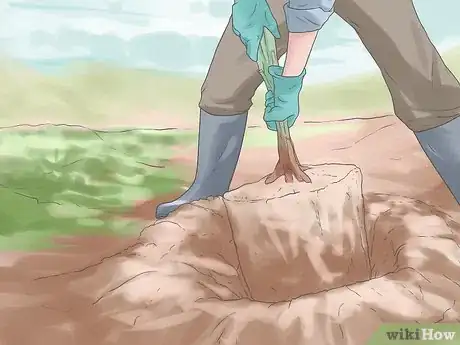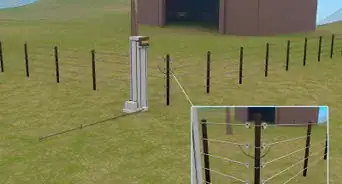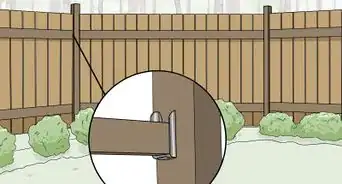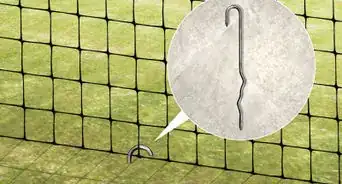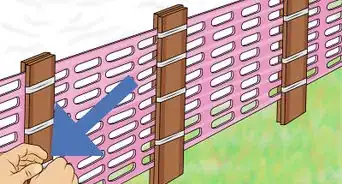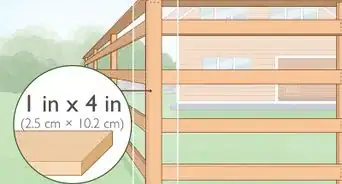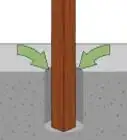This article was co-authored by Anthony "TC" Williams. Anthony "TC" Williams is a Professional Landscaper in Idaho. He is the President and Founder of Aqua Conservation Landscape & Irrigation, an Idaho Registered Landscape Business Entity. With over 21 years of landscaping experience, TC has worked on projects such as the Idaho Botanical Garden in Boise, Idaho. He is a Idaho Registered Contractor and a previously Licensed Irrigator in the State of Texas.
wikiHow marks an article as reader-approved once it receives enough positive feedback. In this case, 86% of readers who voted found the article helpful, earning it our reader-approved status.
This article has been viewed 498,069 times.
If you need to keep livestock contained, or wild animals and other intruders out of your yard, electric fencing may be a good option for you. Both humane and effective, electric fence lines can be used to enclose a pasture or garden, and are simple to install and maintain. See Step 1 for more information.
Steps
Getting Started
-
1Plan your layout. How big of an enclosure or barrier do you need to create for your purposes? Consider the number of animals you need to control and determine the spacing and number of wires you need to use to install electric fencing. If you've got a particular plot set aside for your electric enclosure, take careful measurements and decide on an appropriate height for your fence.
- Decide on the length of each run, as well as the height and the number of wires necessary to complete the job. Price the wires per foot at your retailer to get the best deal possible.
- Different chargers are optimized for different lengths of wire. Check with your supplier to make sure that the charger you intend to get will work with the planned length of wire for your enclosure.
-
2Decide how many brace corners you'll need. Each corner of the electrical fence will need to be braced with a corner piece. 1 brace will suffice at ends and corners with 6 or fewer lines. 7 or more lines require a double brace when putting in fencing.Advertisement
-
3Get enough fence posts. You'll need a lot of posts, especially if you're going to lay a fence of substantial size. Wood posts are perfectly durable and effective, though they'll have a tendency to degrade over time, while metal posts are the easiest to set in the ground, but may end up being more expensive.[1]
-
4Select a charger. To keep the electric fence juiced, you need a charger that will keep electrical current powering the fence wires. Solar charges do not need an electric outlet but they require a certain amount of sunlight, which can be an effective and energy-efficient option in your area. Electric chargers must have access to an AC outlet.
- Don't buy chargers with foot or mile power ratings, instead select a charger that's rated by joules. A higher rating in terms of joules doesn't mean that the charge will be stronger if an animal gets jolted, it just means that the electrical current will be more consistent, making a high-joule charger the smartest purchase. If you've got a five acre fence, you'll need at least a joule at the minimum.
-
5Choose your wire. You can install electric fencing with electric fence tape or a variety of straight wire of various thicknesses. Tape is the easiest to see, and less dangerous than straight wire.
- Making sure that the fencing is easy to see is one of the most important considerations. 1.5- or 2-inch poly tape, braid, rope are perfectly effective for most purposes. Coated wire is likewise easy to see and to install. Half inch tape is probably too small for a more substantial fence, especially for horses or keeping deer out.
Setting up the Fence
-
1Set up your charger. Look for a weather-resilient spot near an AC outlet to install an electric charger, or an area that receives plenty of sunlight for a solar charger.
- To keep the charger protected, hang the charger on a post or wall of an outbuilding. Do not turn the charger on until you've installed the fence.
-
2Put in grounding posts. To install electric fencing, you need at least 1 grounding post that is 6 feet (1.8 m) (182.88 cm) or longer. Place 1 grounding rod near the charger and use a post-hole digger/slammer to set the grounding post. Leave at least 2 inches (5.08 cm) of the post above the ground. When installing electric fencing, it's a good idea to set another grounding post 10 feet (304.80 cm) to 20 feet (6.1 m) (609.60 cm) from the first post.
-
3Attach a grounding wire. The wire needs to extend from the ground terminal of the charger to all the grounding posts. Secure the wire to the posts with a grounding clamp.
-
4Install your fence posts. Use a long string to mark a straight line for your posts and use a post-hole digger to set them securely in the ground. As a general rule of thumb, at least 1/3rd of the overall length of your post should be under the ground. Corner posts should be larger in diameter than the posts along the sides, and should also be installed with at least 1/3rd of their length under the ground, and/or should be properly braced.
- Don't use too many posts. A common mistake is to install posts too frequently, thinking this will result in a stronger and more secure fence. However, if you do plan to install your posts 40 feet (12.2 m) or more apart, you should install stays along the wires to keep them evenly spaced and create greater stability.
-
5Set up braces on corners and gates. To install electric fencing properly, the posts exposed to the most stress need to be reinforced with braces, cement footings or anchors. Many cattle ranchers will use what's called a "floating diagonal” brace, which means the angle brace is a 4-in. by 10-ft. post notched a half-inch into the main corner post, with the other end set on the ground opposite the corner.[2]
-
6Mount the insulators. Because you need to keep the electricity in the wires and away from the posts, insulators are important to install. It'll depend on the type of fence wire you purchase, because manufacturers will usually include and design insulators tailored to their products.
- Most common are insulators that allow braided or rope style fencing enough space to slide through, helping to avoid rubbing.
-
7Run the wire. Use connector clamps included with your variety of fencing wire to mount the wire on the posts. Begin at the post that's the farthest away from the charger, hang as many lines of wire you need to charge the line.
- Never just wrap the wire around the fence posts, because the cable will come loose more easily and corrosion can occur. Use the connector clamps provided by the manufacturer.
- The wires will need to be pulled taut at the anchor end. There are a variety of methods for doing this: you could install a self-locking ratchet-style wire tensioner, use a come-along cable puller, or install a turnbuckle cable tensioner.
- Tighten the wire as much as possible, but take care not to place so much tension on it that it breaks, as this can result in serious injury.
Testing the Line
-
1Turn the charger on. Use a voltmeter to test the lines to ensure the electricity flows through the entire fence. Write down the voltage and keep the number on hand to compare to daily checks of the current. Depending on the strength of your charger, it should read somewhere between 6000 and 10,000 volts, unconnected.
-
2Charge the line. Connect the lines together with a 10 to 14-gauge jumper wire and attach a jumper wire from the top line of the electric fence to the charger. Recheck all the lines before you turn the charger on.
-
3Recheck the voltage. After everything is attached, recheck the voltage at a point farthest away from the charger. You should notice a slight drop in voltage, but no more than 2000 volts, which might mean you've got a short-circuit or some kind of interference in the fence.
-
4Schedule daily checks of the current. It's good to check regularly to prevent signal problems and to make corrections as necessary. Moisture and vegetation build-up can cause temporary leeching of the current, leading you to get lower-voltage readings. If your current is lower than usual, it might be time to do a closer inspection of your work and fix it up.
-
5Keep shrubs and weeds away from your fence. Grasses, bushes, and weeds growing up along your fence can lead to a loss of voltage. Remove any plants that have grown up along your fence, and spray a glyphosate herbicide (like RoundUp) to reduce plant growth in the area.
Expert Q&A
Did you know you can get expert answers for this article?
Unlock expert answers by supporting wikiHow
-
QuestionHow do we connect the electricity to another high-tension wire?
 Anthony "TC" WilliamsAnthony "TC" Williams is a Professional Landscaper in Idaho. He is the President and Founder of Aqua Conservation Landscape & Irrigation, an Idaho Registered Landscape Business Entity. With over 21 years of landscaping experience, TC has worked on projects such as the Idaho Botanical Garden in Boise, Idaho. He is a Idaho Registered Contractor and a previously Licensed Irrigator in the State of Texas.
Anthony "TC" WilliamsAnthony "TC" Williams is a Professional Landscaper in Idaho. He is the President and Founder of Aqua Conservation Landscape & Irrigation, an Idaho Registered Landscape Business Entity. With over 21 years of landscaping experience, TC has worked on projects such as the Idaho Botanical Garden in Boise, Idaho. He is a Idaho Registered Contractor and a previously Licensed Irrigator in the State of Texas.
Experienced Landscaper
-
QuestionI want to make a corral instead of a straight line fence. Where do I start stringing with ewire if it has to be the post furthest away from the charger? How do I connect the wire to complete the circle/corral?
 Anthony "TC" WilliamsAnthony "TC" Williams is a Professional Landscaper in Idaho. He is the President and Founder of Aqua Conservation Landscape & Irrigation, an Idaho Registered Landscape Business Entity. With over 21 years of landscaping experience, TC has worked on projects such as the Idaho Botanical Garden in Boise, Idaho. He is a Idaho Registered Contractor and a previously Licensed Irrigator in the State of Texas.
Anthony "TC" WilliamsAnthony "TC" Williams is a Professional Landscaper in Idaho. He is the President and Founder of Aqua Conservation Landscape & Irrigation, an Idaho Registered Landscape Business Entity. With over 21 years of landscaping experience, TC has worked on projects such as the Idaho Botanical Garden in Boise, Idaho. He is a Idaho Registered Contractor and a previously Licensed Irrigator in the State of Texas.
Experienced Landscaper
-
QuestionWhat about the ends of the runs? What about entrance points?
 Community AnswerThe end of runs will simply be made into a loop and wound over on itself. It does not have to be a full circuit and can easily be used with one to three sides.
Community AnswerThe end of runs will simply be made into a loop and wound over on itself. It does not have to be a full circuit and can easily be used with one to three sides.
Warnings
- Never use barbed wire on an electric fence.⧼thumbs_response⧽
- Don't stand near the fence during an electrical storm.⧼thumbs_response⧽
Things You'll Need
- Electric or solar charger
- Wood or metal posts
- Electric fencing wire or tape
- Grounding post
- Sledgehammer or post slammer
- Grounding wire
- Grounding clamp
- String
- Posthole digger
- Corner braces
- Electric fence insulators
- 10 to 14-gauge jumper wire
- Voltmeter
References
About This Article
To install an electric fence, start by setting up an electric charger near an AC outlet or a solar charger in a sunny spot. Then, install at least 1 grounding post that's 6 feet or longer near the charger using a post-hole digger. Once you've done that, run a grounding wire from the charger to all of the grounding posts. Next, install your fence posts, making sure they're not too close together but not more than 40 feet apart. After you install the fence posts, brace the corners and gates to reinforce them. Finally, mount the insulators on the posts and run the wire between them. To learn how to design the layout for an electric fence, keep reading!
